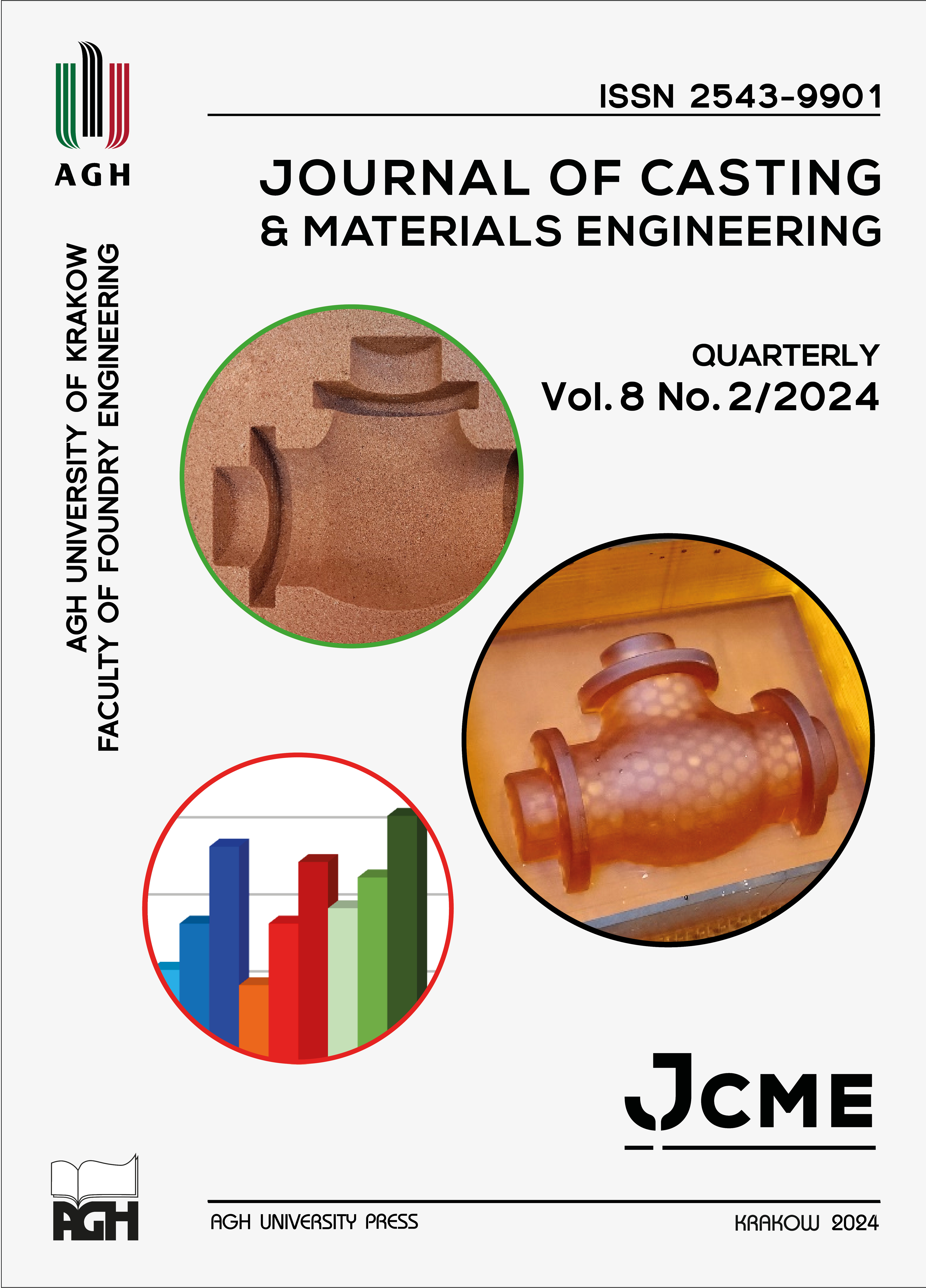Evaluation of 3D-printed Pattern Material for Heat-hardened Inorganic Moulds
DOI:
https://doi.org/10.7494/jcme.2024.8.2.25Keywords:
solid silicate, inorganic binder, additive manufacturing, patternmaking, heat hardeningAbstract
Inorganic binders for sand moulding are currently of high interest due to the need to lessen our environmental impact and emissions. In this study, a heat hardened solid inorganic sodium silicate binder was tested with a 3D printed resin material to see how the use of such a material affected a silica mould’s quality, e.g. surface roughness. Results were compared to moulds made with metallic patterns. The unmodified binder had sticking issues when used with a metallic pattern, resulting in a rough as-moulded surface. Such issues were not seen with the printed resin patterns, also hinting at good performance with binders that contain performance increasing additives. The resin pattern material has a Heat Deflection Temperature (HDT) of 230°C, enabling the use of inorganic binders that require temperatures between 160–200°C to harden and dry. Additive manufacturing of such materials also allows designs for other hardening techniques than furnace heating, such as microwave heating. The moulds hardened with microwaves did not exhibit sticking issues. Additive manufacturing of tooling is a potential source of geometrical variation in final castings and are also studied in this work. In general, switching from traditional sand moulding patterns used with organic binder systems to inorganic systems, the patterns and core boxes need to be replaced by new ones made of a metallic or other heat resistant material. The studied material is a promising option for such a switch, especially when a complex shape enabled by additive manufacturing is also required.
Downloads
References
Miao H., Du X., Sun Y., Zhang M. & Song G. (2021). Effect of powder breakdown additives on properties of ester-hardened sodium silicate bonded ceramic sand. International Journal of Metalcasting, 15(2), 710–718. Doi: https://doi.org/10.1007/s40962-020-00517-z.
Zaretskiy L. (2018). Hydrous solid silicates in new foundry binders. International Journal of Metalcasting, 12(2), 275–291. Doi: https://doi.org/10.1007/s40962-017-0155-6.
Anwar N., Jalava K. & Orkas J. (2022). Experimental study of inorganic foundry sand binders for mold and cast quality. International Journal of Metalcasting, 17(3), 1697–1714. Doi: https://doi.org/10.1007/s40962-022-00897-4.
Malachowska A., Stachowicz M. & Granat K. (2012). Innovative Microwave Hardening of Water-Glass Containing Sandmixes in Technical-Economic Approach. Archives of Foundry Engineering, 12(1), 75–80. Doi: https://doi.org/10.2478/v10266-012-0015-z.
Granat K., Nowak D., Pigiel M., Stachowicz M. & Wikiera R. (2007). The influence of hardening method on basic properties of water glass molding sands. Visnik Chmel’nickogo Nacional’nogo Universitetu, 1(4), 98–104.
Polzin H. (2014). Inorganic Binders: For Mould and Core Production in the Foundry. Schiele & Schön, Berlin.
Ramakrishnan R., Griebel B., Volk W., Günther D. & Günther J. (2014). 3D printing of inorganic sand moulds for casting applications. Advanced Materials Research, 1018, 441–449. Doi: https://doi.org/10.4028/www.scientific.net/amr.1018.441.
Zmarzły P., Kozior T. & Gogolewski D. (2019). Dimensional and shape accuracy of foundry patterns fabricated through photo-curing. Technical Gazette, 26(6), 1576–1584. Doi: https://doi.org/10.17559/TV-20181109115954.
Brackett J., Yan Y., Cauthen D., Kishore V., Lindahl J., Smith T., Sudbury Z., Ning H., Kunc V. & Duty C. (2021). Characterizing material transitions in large-scale. Additive Manufacturing, 38. Doi: https://doi.org/10.1016/j.addma.2020.101750.
Billah K.M.M., Heineman J., Mhatre P., Roschli A., Post B., Kumar V., Kim S., Haye G., Jackson J., Skelton Z., Kunc V. &Hassen A.A. (2021). Large-scale additive manufacturing of self-heating molds. Additive Manufacturing, 47. Doi: https://doi.org/10.1016/j.addma.2021.102282.
Downloads
Published
Issue
Section
License
Copyright (c) 2024 Kalle Jalava, Nurul Anwar, Juhani Orkas

This work is licensed under a Creative Commons Attribution 4.0 International License.
How to Cite
Accepted 2024-05-07
Published 2024-06-05


